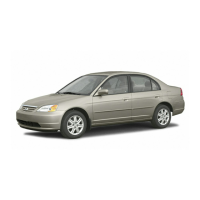Continuously Variable Transmission Models: The power mode is in ACCESSORY
when the engine is stopped. To change the mode to VEHICLE OFF, put the
transmission into P after the vehicle comes to a complete stop.
Canadian Continuously Variable Transmission Models: Then press the ENGINE
START/STOP button twice without depressing the brake pedal.
Manual transmission models: The power mode changes to VEHICLE OFF.
Do not press the ENGINE START/STOP button while driving unless it is
absolutely necessary for the engine to be switched off.
If you press the ENGINE START/STOP button while driving, the beeper sounds.
HANDLING THE UNEXPECTED
146 |
Emergency Towing
Call a professional towing service if you need to tow your vehicle.
Flat bed equipment: The operator loads your vehicle on the back of a truck. This
is the best way to transport your vehicle.
Wheel lift equipment: The tow truck uses two pivoting arms that go under the
front tires and lift them off the ground. The rear tires remain on the ground. This
is an acceptable way to tow your vehicle.
Trying to lift or tow your vehicle by the bumpers will cause serious damage. The
bumpers are not designed to support the vehicle’s weight.
Improper towing such as towing behind a motorhome or other motor vehicle
can damage the transmission.
Never tow your vehicle with just a rope or chain. It is very dangerous since
ropes or chains may shift from side to side or break.
Make sure the parking brake is released. If you cannot release the parking
brake, your vehicle must be transported by the flat bed equipment.
Tire Pressure Monitoring System (TPMS)
*1
Instead of directly measuring the pressure
in each tire, the TPMS on this vehicle
monitors and compares the rolling radius
and rotational characteristics of each
wheel and tire while you are driving to
determine if one or more tires are
significantly under-inflated. This will cause
the low tire pressure/TPMS indicator to
come on and a message to appear on the
driver information interface.
Reasons for the indicator to come on or blink
If your vehicle's tire pressure becomes significantly low, or the TPMS has not
been calibrated. If there is a problem with the TPMS or the compact spare tire
*1
is installed, the indicator blinks for about one minute, and then stays on.
Conditions such as low ambient temperature and altitude change directly affect
tire pressure and can trigger the low tire pressure/TPMS indicator to come on.
*1 - If equipped
HANDLING THE UNEXPECTED
| 147

